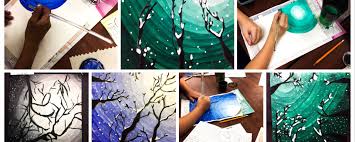Exploring the Artistry of Acrylic Painting: A Comprehensive Guide
Table of Contents
Introduction:
Acrylic painting stands as a vibrant and dynamic form of artistic expression, offering a versatile medium for creators to convey their emotions, ideas, and visions onto canvas. With its fast-drying properties, rich pigments, and diverse application techniques, acrylics have become a favorite among artists of all skill levels. In this comprehensive guide, we delve deep into the world of acrylic painting, exploring its history, techniques, materials, and the boundless creativity it offers.
History and Evolution of Acrylic Painting:

Acrylic painting emerged in the mid-20th century as a groundbreaking innovation in the world of fine art. Developed as an alternative to oil and watercolor paints, acrylics offered artists a fast-drying, water-soluble medium with vivid colors and versatile application methods. The invention of acrylic paint marked a significant shift in artistic practices, allowing for greater experimentation, spontaneity, and freedom in the creative process.
Key Characteristics of Acrylic Paint:
Acrylic paint is renowned for its unique characteristics, including its quick drying time, water solubility, and flexibility when dry. Unlike oil paints, which can take days or even weeks to dry, acrylics dry rapidly, enabling artists to work quickly and build up layers of color with ease. Additionally, acrylic paint can be diluted with water to create translucent washes or applied thickly for impasto effects, offering endless possibilities for texture, opacity, and finish.
Essential Materials and Tools:

To embark on an acrylic painting journey, artists require a selection of essential materials and tools. These include acrylic paints in various colors, high-quality brushes in different shapes and sizes, a palette for mixing colors, canvas or painting surface, and mediums for altering the consistency and drying time of the paint. Additionally, artists may use auxiliary tools such as palette knives, sponges, and spray bottles to achieve different effects and textures in their work.
Basic Techniques and Application Methods:
Acrylic painting encompasses a wide range of techniques and application methods, each offering unique effects and possibilities for artistic expression. Some of the fundamental techniques include:
Wet-on-Wet: Applying wet paint onto a wet surface to create blended, seamless transitions between colors.
Dry Brush: Using a dry brush with minimal paint to create textured effects and fine details.
Glazing: Building up translucent layers of color over a dried base to create depth, luminosity, and richness in the painting.
Impasto: Applying thick, heavily textured paint with palette knives or brushes to create three-dimensional surface effects.
Pouring: Pouring diluted acrylic paint onto the canvas and allowing it to flow and blend organically to create abstract patterns and compositions.
Exploring Creativity and Inspiration:
Acrylic painting offers artists endless opportunities for creativity, experimentation, and self-expression. Whether painting from observation, imagination, or memory, artists can draw inspiration from a wide range of subjects, including landscapes, still lifes, portraits, abstracts, and more. By exploring different techniques, styles, and subjects, artists can discover their unique voice and develop a signature style that reflects their personality, experiences, and artistic vision.
Challenges and Solutions:
While acrylic painting offers many advantages, artists may encounter challenges along the way, such as color mixing, drying time, and paint consistency. However, with practice, experimentation, and a willingness to learn, artists can overcome these challenges and harness the full potential of acrylic painting. Techniques such as color theory, underpainting, and layering can help artists achieve the desired effects and create compelling works of art.
Conclusion:
In conclusion, acrylic painting is a vibrant and dynamic medium that offers artists endless possibilities for creativity, experimentation, and self-expression. With its quick-drying properties, rich pigments, and versatile application techniques, acrylics have become a favorite among artists of all levels. By exploring the history, characteristics, techniques, and creative potential of acrylic painting, artists can embark on a fulfilling artistic journey filled with discovery, growth, and artistic expression. So pick up your brushes, squeeze out your colors, and let your imagination soar with acrylic painting—a medium that invites you to explore, create, and transform your artistic vision into reality.
For More Information Please Visit These Websites Craiyon And arturia





